
Abandoned & Little-Known Airfields:
Hawaii, Northern Oahu Island
© 2001, © 2016 by Paul Freeman. Revised 7/17/16.
This site covers airfields in all 50 states: Click here for the site's main menu.
____________________________________________________
Please consider a financial contribution to support the continued growth & operation of this site.
Haleiwa Fighter Strip / Haleiwa Airport (revised 9/13/15) - Kahuku AAF / Kuilima Air Park (revised 10/2/14)
Kailua Sky Ranch (added 3/8/15) - Mokuleia AAF / Dillingham AFB (revised 7/17/16) - Waiele Gulch Army Airfield (added 6/21/14)
___________________________________________________
Kailua Sky Ranch, Airfield, Kailua, HI
21.43, -157.75 (Northeast of Honolulu, HI)

Kailua Sky Ranch, as depicted on the 1952 USGS topo map.
Photo of the airfield has not been located.
Kailua Sky Ranch, a small general aviation airport adjacent to the south side of Naval Air Station Kaneohe Bay, was reportedly “built after World War 2.”
The earliest depiction which has been located of Kailua Sky Ranch was on the 1952 USGS topo map.
It depicted Kailua Sky Ranch as an east/west oriented clearing, with a row of small buildings (hangars?) along the southeast side.
Minutes of a 1956 Hawaii Aeronautics Commission reported of a request from the Aircraft Owners' & Pilots' Association of Hawaii
for the Hawaii Aeronautics Commission to acquire the Kailua Sky Ranch so as to support the continuation of light aircraft flying.
Bob Hurd recalled, “Kailua Sky Ranch... I started to learn to fly there in 1957.
There was an grass field in Kailua, windward side of Oahu. It was located parallel to the southern fence of Kaneohe Marine Base,
near the Mokapu gate to the base, and west of Mokapu Boulevard.
The runway was where the east/west portion of Aikahi Loop is now.
It would have appeared in any sectional published pre-1960.
It had a 200' asphalt strip & about 1,800' of grass,and power lines at the East end, along Mokapu Blvd.
There was a large Quonset hut as a hangar, shop combination, and a small raised house that served as the office & bathroom.
There was a gasoline-powered pump & 3,500 gallon tank of 80/87 avgas.
The field was operated by Robert Whittinghill, who was an instructor at the state aircraft mechanic school at Honolulu Airport.
I remember other Sky Ranch guys & I flying the planes to Honolulu Airport's old North ramp area, where Wittinghill had a large T-hangar & a Fixed Base Operation.”

The 1959 USGS topo map depicted Kailua Sky Ranch as having an east/west runway.
In contrast to the 1952 topo map, only 2 small buildings were depicted along the southeast side.
In 1959, the Hawaii Soaring Club was formed with Wood Brown as President.
Plans called for the operation of Pratt-Read gliders from Kailua Sky Ranch.
Bob Hurd recalled, “Kailua Sky Ranch...I was away at school when it was plowed under for the Aikahi tract.
It was turned into housing about 1962, or so.”

The last depiction which has been located of Kailua Sky Ranch was on the 1965 USGS topo map,
even though it had reported been redeveloped for 3 years by that point.
The 1968 USGS topo map depicted streets covering the site of Kailua Sky Ranch.
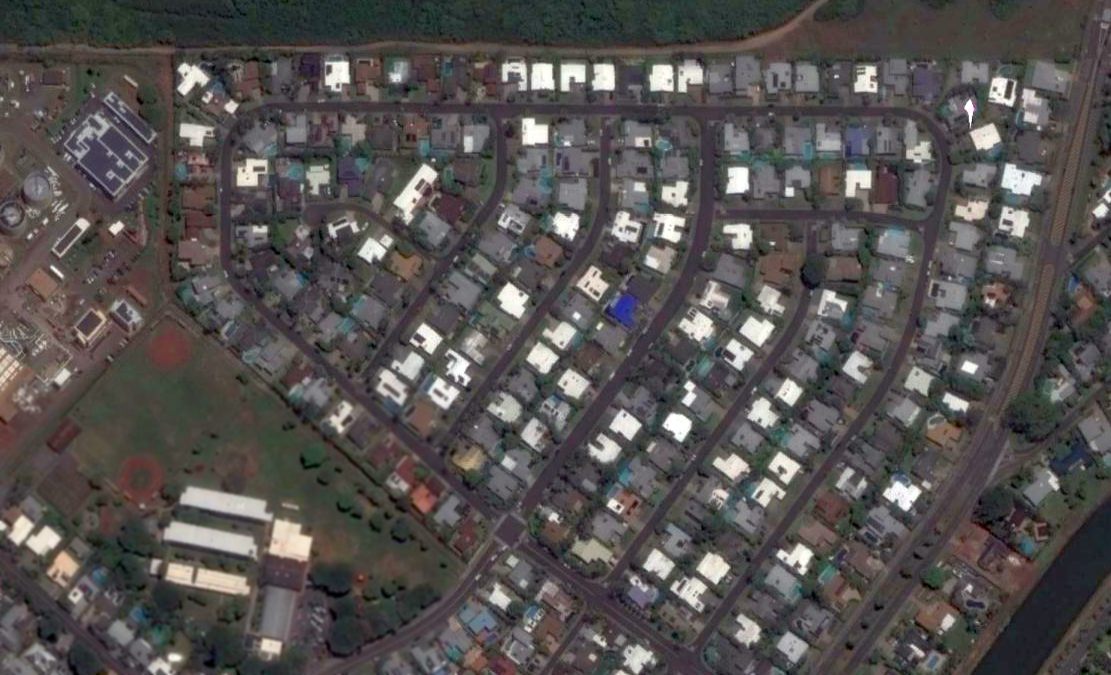
A 2014 aerial view showed no trace remaining of Kailua Sky Ranch.
Thanks to Bob Hurd for pointing out this airfield.
____________________________________________________
Waiele Gulch Army Airfield, Wahiawā, HI
21.47 North / 158.04 West (North of Honolulu, HI)

A 7/9/42 aerial view looking south showing the Waiele Gulch Airfield under construction (courtesy of Ron Plante).
This is an unusual case of an airfield built in a gulch, below the surrounding ground level.
According to the Hawaii Aviation Preservation Society, “The date of construction of the airfield is believed to be in late 1941.
An 8/20/41 photo shows the airfield under construction.
The airfield lies in a gully running parallel to Waieli Stream next to pineapple fields, separate & just south of Wheeler Air Field.
Bunkers were excavated in conjunction with the initial construction of the airfield.
Provision for bombproof protection of assembly & disassembly operations for large bombers
was not worth the expenditure of money & materials required in conjunction with the initial construction.
The initial plan was for paved bunkers for these operations adjacent to the Waieli Gulch runway.
Three 100' x 200' bunkers with paved working areas were provided for this purpose.
Pockets were laid out in the cliffs along the side of the runway were used as aircraft parking areas
with sheer earth side slopes to provide maximum protection from strafing of enemy aircraft.”
According to the Hawaii Aviation Preservation Society, “A huge underground bunker complex
was later constructed at the northwest end of the airfield for aircraft maintenance & storage
after the 12/7/41 attack on Pearl Harbor forced the military to build facilities less vulnerable to the enemy.”
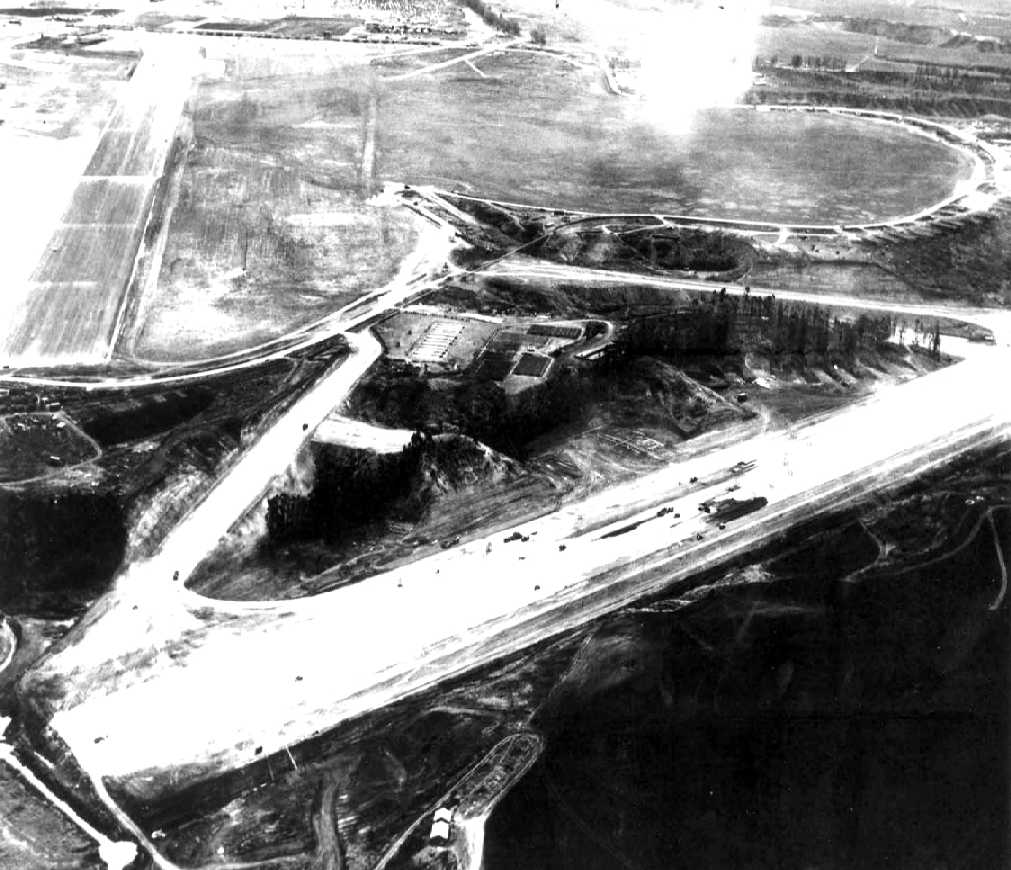
A 1942 aerial view looking east showing the Waiele Gulch Airfield under construction, with a Wheeler AAF runway in the background.
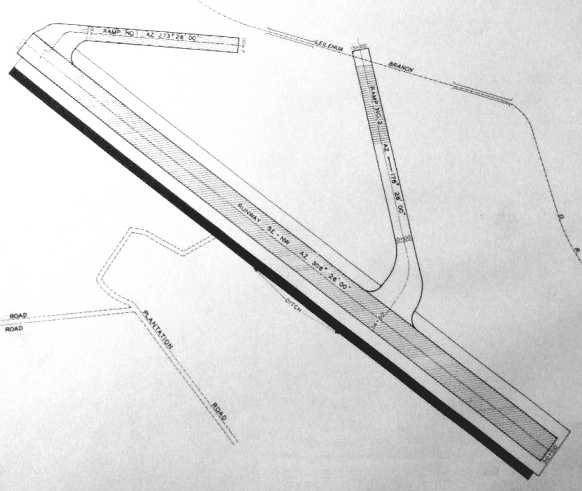
A 1942 plan of the Waiele Gulch Airfield (courtesy of Ron Plante).
According to the Hawaii Aviation Preservation Society, “Construction began in 1942 on a bombproof underground bunker complex & aircraft assembly plant
located 2,400' from the end of the Waieli Gulch Airstrip.
The fear of a repeat-attack prompted the Army & Navy to build these underground facilities for vital defense & storage installations.”
A 1943 U.S. Army Corps of Engineers Schofield Quadrangle map
identified the airfield as Waieli Gulch Field (according to the Hawaii Aviation Preservation Society).
An 11/17/43 aerial photo depicted an active runway (according to the Hawaii Aviation Preservation Society).
According to the Hawaii Aviation Preservation Society, “Called 'The Hole' in the 1940s, construction on the $23,000,000 facility was completed in 1944.
The facility is not a true tunnel, but a freestanding 3-story structure that was later covered with 5' of soil for pineapple cultivation.
The entrance was placed in the steep side of the Gulch to obscure visibility by enemy aircraft.
When construction was completed, it was assigned to the 7th Air Force.”
According to the Hawaii Aviation Preservation Society, “The bunker facility was naturally constructed as an open bay area, without interior cement blocks.
The outer walls are composed of reinforced concrete & dirt.
It is approximately 250,000 square feet in overall size, with 30,000 square feet used for power generation & air conditioning.
The remaining 220,000 square feet were available for assembly or disassembly of aircraft
and was surrounded by smaller repair shops & storage rooms.
The main shop was designed to provide space for three B-17 planes, two without wings & one with wings
and was later modified to accommodate larger bombers.
Access to the structure was via a ramp built on a curve with a 90-degree bend intended to provide protection for the entrance to the bunker.
Aircraft including the B-24s, B-17s, B-26s bombers & other types were serviced in the bunker
but there is no historical evidence to suggest the field station was ever used for aircraft assembly.”
According to the Hawaii Aviation Preservation Society, “The Kunia Bunker was equipped with every modern facility.
The entire facility was air-conditioned & humidity controlled & had a cafeteria that could turn out 6,000 meals a day.
Some idea of the size of the building may be gained from the fact that to light the facility, it took almost 5,000 forty-inch fluorescent tubes for the job.
Two elevators serviced the field station, one capable of accommodating 10 tons for bulky plane parts.
For passenger service, another elevator was provided with a carrying capacity of 20 persons.”

An August 1944 map of the “Waiele Strip”.
According to the Hawaii Aviation Preservation Society, “At the end of World War II, the [bunker] facility was kept in a reserve status.
Waieli Gulch Field was apparently abandoned shortly after the end of World War II most likely because of the hazards of operating an airfield in a gulch.”

A 1948 aerial view depicted the Waiele Gulch runway being used to store vehicles.
According to the Hawaii Aviation Preservation Society, “The [bunker] facility was kept in a reserve status until 1953,
at which time the Navy assumed control & used it for ammunition storage & a command center.
It was eventually converted into a communications facility.”
According to the Hawaii Aviation Preservation Society, “The very close proximity of Wheeler Field will prevent this airfield from ever being reactivated.
Continual erosion along the steep sides of the runway poses major problems & limits the use of the ramp & parking areas.
Maps for 1953, 1967 and 1983 show the end of Waieli Gulch Field connected to Kunia Bunker via a small access road across Kunia road.
An early 1960s era aerial photo depicts the airfield being used as a staging area for deploying troops & equipment.”
Jan Helsel recalled of the 1960s, “While I was stationed at Wheeler we used [the gulch airfield] as a staging area for troop lifts.”
According to the Hawaii Aviation Preservation Society, “Currently no access remains between the airfield & the bunker.
An archaeology and history study completed in 1994 simply identifies the area as Waieli Runway.
The airfield areas were examined for any evidence of artifacts.
An old World War II propeller & 10-ton aircraft jacks were found near the end of the runway.
At the present time, the Waieli Gulch Field area is still used by the Army as a military staging & training area.”

A circa 2000s photo of Quonset huts alongside the Waiele Gulch runway.

A circa 2000s photo looking along the Waiele Gulch runway.

A circa 2011 aerial view looking east along the Waiele Gulch runway shows several modern structures having been built over the western end.
The site of Waiele Gulch Army Airfield is located south of the intersection of Wright Avenue & Airdrome Road.
____________________________________________________
Kahuku Army Airfield / Kuilima Air Park, Kahuku, HI
21.71 North / 157.97 West (North of Honolulu, HI)

A 9/9/41 aerial view looking east at Kahuku Point Outlying Field.
A Marconi Wireless station was established in 1914 on the northern tip of Oahu
as the site for a transmitter/receiver radio station & antenna farm.
This was eventually taken over by the Radio Corporation of America (RCA).
The northern tip of Oahu Island had a total of 3 airfields in close proximity during WW2.
The date of construction of these 3 airfields has not been determined,
but it is presumed that they were all constructed early in WW2,
and were not pre-war civilian airfields.
The Kahuku Point Airfield was located at the very tip of Kahuku Point, and was evidently the most elaborate.
In 1941, Lt. Gen. Walter Short made a request to construct a pursuit field,
and the War Department directed that the base be located on the northern tip of Oahu at Kahuku Point.
Because the site was being used by the Navy as a bombing range, no further action was taken until December 1.
The old RCA administration building was converted to air base headquarters for the duration.
The earliest depiction which has been located of the Kahuku Point Airfield was a 9/9/41 aerial view.
It depicted the field as an open grass area,
with what appeared to be a circular bombing target cut into the grass.
There did not appear to be any hangars or other improvements associated with the airfield.
The military reservation was named the "Kahuku Airfield Military Reservation", also known as "Kahuku Air Base".
Construction of the first of 2 runways was preceded by the creation of a supervising entity known as Field Area 13
established by Lt. Col. Theodore Wyman, Army Corps of Engineers District Engineer, on 11/25/41, by Order 101.
The engineers of the newly created field area, which occupied the old RCA wireless transmitter building,
were responsible for construction of 2 additional north shore airfields at Haleiwa & Kawaihapai (Mokuleia).
Construction of the airfield began on 12/10/41, by a civilian conglomerate known as "Hawaiian Constructors" formed in Washington, D.C., on 12/20/40.
Lt. Colonel Wyman, with the approval of the Under Secretary of War, Chief Engineer & the National Council of Defense,
signed a "cost plus fee" contract to build fortifications, aircraft warning stations, ammunition storage facilities,
and other defense projects in the Hawaiian Islands including airfields.

The Kahuku Point Airfield evidently gained a paved runway at some point between 1941-42,
as an 8/20/42 aerial photo depicted a long paved runway.
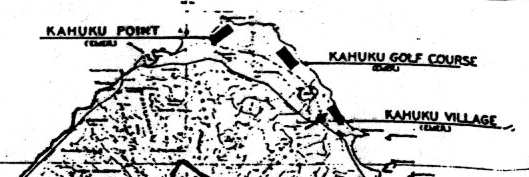
The 1943 USGS topo map (courtesy of John Voss) depicted the "Kahuku Point" Airfield,
as well as 2 others, further down the coast to the southeast: "Kahuku Golf Course" & "Kahuku Village".
All 3 of the Kahuku airfields were subtitled "Emer",
and were depicted as single runways paralleling the shore.
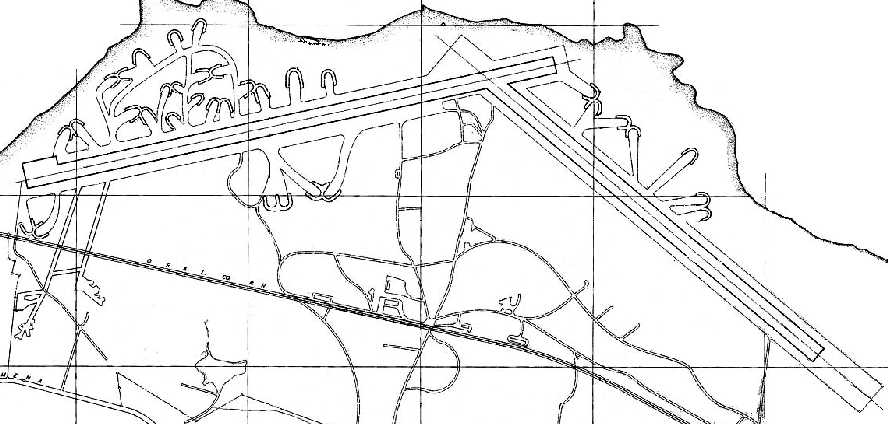
A 1943 Army Corps of Engineers plan of “Kahuku Field” (courtesy of Robert Hill & John Bennett, via John Szalay)
depicted the field as having 2 paved runways, with no less than 36 parking revetments arrayed around the runways.

A 9/19/44 aerial view of a Republic P-47D Thunderbolt overflying Kahuku Field (courtesy of John Voss).

A circa 1944-45 photo of Sam Rogers in the cockpit of “Alice The Goon”, a B-25G (or B-25H, with the 75mm cannon solid nose) at Kahuku (courtesy of Sam Rogers Jr.).
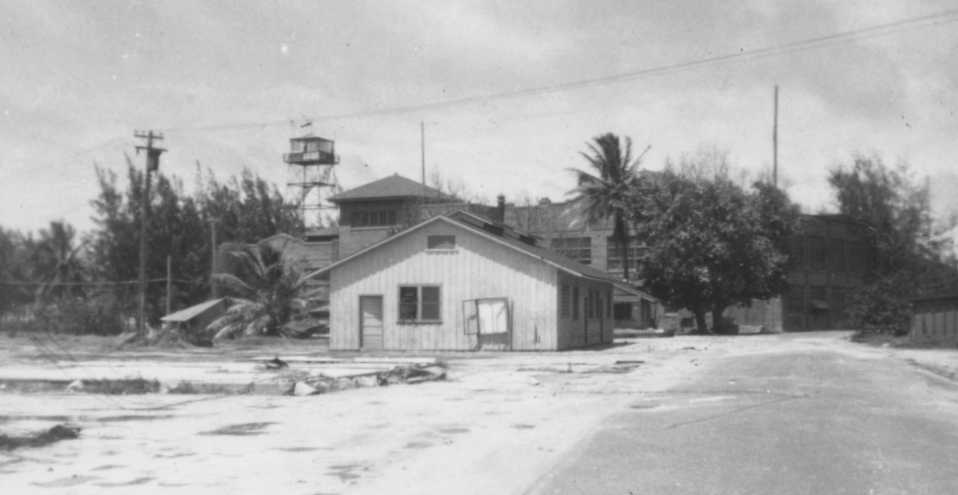
A circa 1944-45 photo by Sam Rogers of the Kahuku control tower & other buildings (courtesy of Sam Rogers Jr.).

A circa 1944-45 photo by Sam Rogers of the Kahuku's runway (courtesy of Sam Rogers Jr.).
According to John Szalay, both B-24s & B-17s were based at Kahuku for short periods of time during WW2.
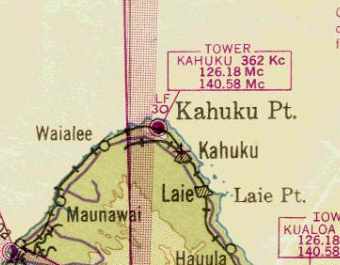
The April 1945 V-450 Hawaiian Islands U.S. Navy Aviation Chart (courtesy of Chris Kennedy)
depicted the airfield at Kahuku Point as having a control tower.
Also note the “cross” symbol (depicting an “Emergency Field”) to the southeast, at the location of the "Kahuku Golf Course" Airfield.
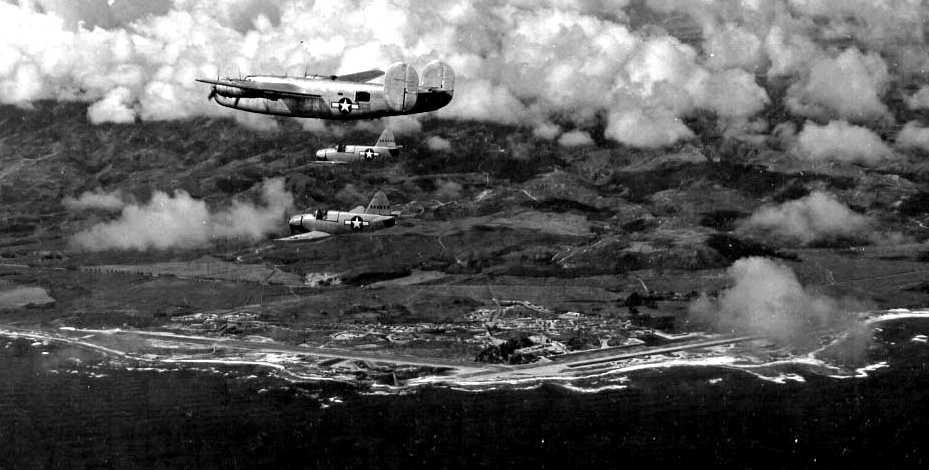
A 4/29/45 National Archives aerial view looking south at a B-24 mother ship escorting 2 rare Culver PQ-14 radio-controlled planes,
with the runways of Kahuku AAB visible below.
According to an article in the Spring 2001 AAHS Journal,
“The large Tsunami that hit the Hawaiian Islands on 4/1/46, caused extensive damage to the air base,
the NE/SW runaway was within 100 yards of the shoreline and the NW/SE runway, 200 yards.”
According to a Corps of Engineers DERP FUDS report, “The wave washed over the protecting sand dunes,
rushing inland in some places to a half mile, smashing buildings, uprooting parking areas, and bringing tons of sand & debris onto the runways.
Army personnel verbally informed the Estate that their previous fear that the field was too close to the water was amply borne out.”

"Kahuku AAB" was depicted on the 1947 Hawaiian Islands Sectional Chart (courtesy of John Voss)
as a closed airfield, having a 6,500' hard-surface runway.
This was presumably the former "Kahuku Point" Airfield.
The other 2 Kahuku airfields were not depicted at all.
According to an article in the Spring 2001 AAHS Journal,
“Flight operations ceased, and the property was returned to its owners, the trustees of the James Campbell Estate
sometime between 6/12/47 - March 1948.”
According to an article in the Spring 2001 AAHS Journal,
“The formation of the U.S. Air Force on 9/18/47, saw the continued occupation of a base camp located on 10 acres of the military reservation.
The camp housed Det. B, 614th Aircraft Control and Warning Squadron which operated a GCI radar until 1/1/49,
and the 616th Aircraft Control & Warning Squadron that manned an AN/CPS-1 early warning radar unit atop nearby Punamano Hill until 12/11/48.”

A June 29, 1951 aerial view looking southwest at the Kahuku airfield (from the University of HI) showed 2 paved runways.
Walter Dick recalled, “Kahuku... I was one of the group that initiated drag racing at the Kahuku strip.
I was a 'founder' of the local hot rod club (circa 1952).
We negotiated with the local Philipino farmer leaseholder for access to the site.
We used the end of the South segment of the strip. We had to chase the cows off before we could race.
The North segment of the strip had the antenna field for the RCA short-wave transmitting site
and also served as a National Guard summer campground.
Most of the middle was covered in blowing sand then.”
No airfield at Kahuku was depicted on the October 1954 Hawaiian Islands Sectional Chart (courtesy of Chris Kennedy).

The 1954 USGS topo map depicted the “Kahuku Airfield (Abandoned) as having 2 parallel paved northeast/southwest runways,
and a 3rd paved runway oriented northwest/southeast.

A 1955 aerial view depicted the 2 Kahuku runways, as well as the multiple antennae of the RCA radio station.

The Official Program for the 9/2/56 First Running of the Kahuku Point Sports Car Races (courtesy of Sheila Fontaine).
According to John Szalay, "In the early 1960s prior to the opening of the Campbell race course,
we used to race at Kahuku, both drag racing & the first Hawaii sports car race (Grand Prix).
I remember one long runway & a taxiway with a wide area to the south on the west end of the runway.
There were a couple of small parking spots for aircraft on the northern part (seaside)
but in the 1960s they were almost covered by blowing sand & grass."
According to an article in the Spring 2001 AAHS Journal,
“Portions of the old NW/SE runway were used for automobile drag racing in the 1950s to 1960s until operations
were relocated to the Campbell Industrial Park at Barbers Pt.”
In January 1961, the area northwest of the town of Kahuku was used as the location of the Army's OA-17 Nike missile battery,
part of a network of 4 Nike surface-to-air missile batteries in Oahu.

An undated photo of several Nike missile radar domes at Kahuku,
from the June 1964 Hawaii Guardsman.
A 1965 aerial view depicted the 2 Kahuku runways remaining intact.
The Kahuku OA-17 Nike missile battery was deactivated in March 1970.
David Falconer recalled, “When I lived on Oahu [1971-74]
I met the people that were running the RCA radio site [at the site of the Kahuku airfield].
I was told that the airfield was a reloading air strip for the bombers from the bunkers in the hills.
While they were building the airstrip the army lost a couple of bulldozers in the sand
due to the volcano tubes that ran underneath the sand.
This radio station was the one that put out the message about Pearl Harbor being bombed
and was the only communications link to the mainland.
It was built to support the B-17's that was why it had 2 long runways with asphalt & concrete.
There was a rail line that moved the bombs/ammunition from the hills to the runway.”
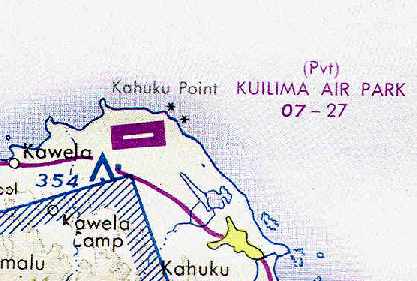
At some point between 1954-77 the former Kahuku Point airfield was apparently reused as a private civil airfield,
as that is how "Kuilima Air Park" was depicted on the December 1977 Hawaiian Islands Sectional Chart (courtesy of Chris Kennedy).
It was depicted as having a single 2,700' hard-surface runway.
Bob Gould recalled, “I've landed on one of the old abandoned runways at Kahuku Airfield in a Cherokee 6.
That was in the mid-1970s.”

The 1983 USGS topo map depicted a single 2,800' runway
at the location of the former Kahuku Point Airfield, labeled simply "Landing Strip".
However, it also depicted much longer (5,200') cleared area resembling another runway,
running south of the "Landing Strip" to the south.
At the site of the former Kahuku Golf Course Airfield, it depicted a 6,500' long cleared area, unlabeled.
At the site of the former Kahuku Village Airfield, it depicted the "Kahuku Golf Course".

The 2000 NOAA aerial view of the site of the former Kahuku Golf Course Airfield
shows that a considerable length of the asphalt runway remains intact.

The 2000 NOAA aerial view of the site of the former Kahuku Point Airfield
shows that it has been redeveloped as a hotel golf course,
and not a trace appears to remain of the former runway.

The 2001 USGS topo map depicted 2 parallel runways (2,800' & 4,200')
at the site of the former Kahuku Point Airfield, labeled "Kahuku Airfield".
It depicted a single 2,800' runway at the site of the former Kahuku Golf Course Airfield, labeled "Landing Strip".
It did not depict anything at the site of the former Kahuku Village Airfield.
According to the Hawaiian Aviation History Pages,
Kahuku Army Air Field is located just east of the Turtle Bay Hilton,
and the Hilton's golf course has absorbed most of one of the 2 runways.
That site also reported of "a rumor about it becoming a private airport
to service the Polynesian Cultural Center for tourists from other islands."
CW2 Matt Hobbs (an Army Blackhawk pilot stationed at nearby Wheeler AAF) reported in 2004,
"I fly over the old runway at Kahuku often.
It looks like there are the remnants of an old operations building or something."

A 2004 aerial view looking southeast at the northwestern end of the former Kahuku Golf Course Airfield runway.
Ando Hiroshi reported in 2004, "The building where 2 runways merge
is the original Marconi radio transmitter facility.
It's been long gone & they are building something new there.
Way back when, Marconi from Italy installed the first radio transmitter in the US with conjunction with RCA
and they used to have a big antenna over there."

A 2004 aerial view looking south at the southeastern end of the former Kahuku Golf Course Airfield runway.

A circa 2007 aerial view looking south at the remains of the runway intersection at Kahuku.
Walter Dick reported in 2009, “The south end [of the former airfield property] is now a wildlife refuge.”
According to an article in the Spring 2001 AAHS Journal,
“The lands upon which Kahuku AAB once occupied are divided between a resort hotel & golf course, aquaculture farming,
ranching, and the 'James Campbell National Wildlife Refuge' with 2 units, Kii & Punamano.
Development of the hotel & golf course have almost obliterated all traces of the original NE/SW runway,
and aquaculture ponds cover a great portion of the NW/SE runway,
which is in an advanced state of abandonment & has been turned over to the stewardship
of the U.S. Fish & Wildlife Service as part of the Punamano Unit’s expansion.”

An 8/23/14 photo by Timothy Williamson of the ruins of the Marconi station buildngs at Kahuku.

An 8/23/14 photo by Timothy Williamson of the remains of the Kahuku runway.
____________________________________________________
Haleiwa Fighter Strip / Haleiwa Airport, Haleiwa HI
21.6 North / 158.1 West (Northwest of Honolulu, HI)

An April 27 1933 aerial view looking east at Haleiwa Airfield,
(courtesy of the 15th Airlift Wing History Office, via Colin Perry of the Hawaii Aviation Preservation Society),
showing several B-6A biplanes on the field.
The date of construction of the Haleiwa airfield has not been determined.
The earliest depiction of the field which has been located
was 4/27/33 aerial photo at the Hawaiian Aviation History Pages,
which depicted a group of B-6A biplanes on a modest grass field at Haleiwa.
This obscure former military strip became famous as the only airfield from which American fighters
were able to launch to mount a defense against the Pearl Harbor Attack in 1941.
From the book "The Way It Was: Pearl Harbor, The Original Photographs" (via Tom Kramer):
"Bellows was palatial beside Haleiwa Field, which had no installations at all.
Originally used as an emergency landing field,
in 1941 it had only an unpaved landing strip & it was in use to simulate real battle conditions for gunnery training.
Those on temporary duty there had to bring their own tents & equipment.
On 7 December, the 47th Pursuit Squadron was at Haleiwa & there had its first taste of actual combat."
"The Americans took off - or tried to take off - in 3 distinct groups.
The most successful were 5 pilots from the 47th Pursuit Squadron
who survived a wild ride in 2 separate cars up from Wheeler Field,
where they had spent the night, to Haleiwa Field, where their squadron was training.
Just enough aircraft were available - five P-40s & a P-36A.
These 5 fliers accounted for as many as 7 aircraft.
The most successful, 2nd Lt. George Welch (4 victories),
took off first & engaged the enemy over Ewa & Wahialua.
Taylor & Welch were both awarded the Distinguished Service Cross."
Walsh & Taylor's dramatic ride & takeoff was shown in "Tora, Tora, Tora",
though the strip used in the filming of that movie was up near Wheeler Field & surrounded by hills.

A 1942 aerial view looking west at Haleiwa Airfield
(courtesy of the 15th Airlift Wing History Office, via Colin Perry of the Hawaii Aviation Preservation Society),
with P-40s visible parked on the field.

A 1942 aerial view of the Haleiwa Airfield
(courtesy of the 15th Airlift Wing History Office, via Colin Perry of the Hawaii Aviation Preservation Society).

A WW2-era view of a P-40 fighter under camouflage netting at Haleiwa (courtesy of Ron Plante).
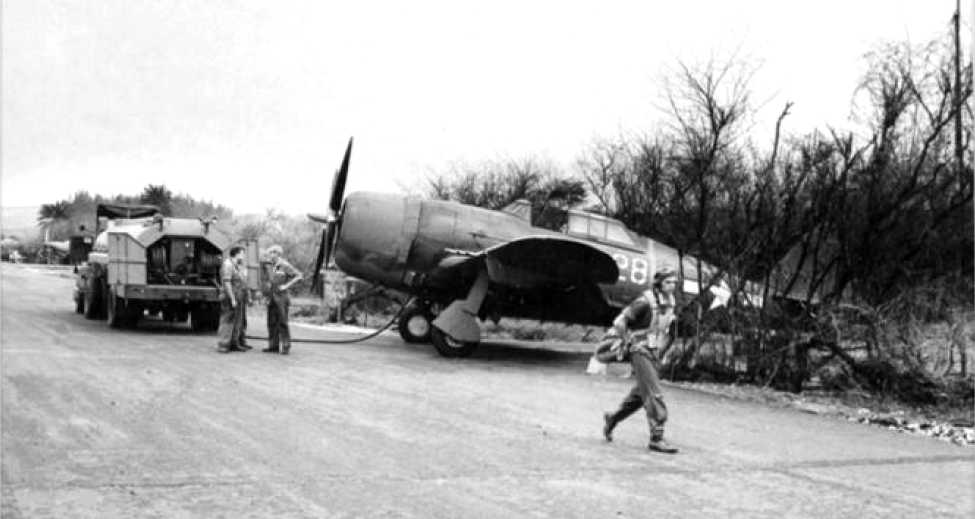
A WW2-era view of a P-47 Thunderbolt being refueled at Haleiwa (courtesy of Ron Plante).


A circa 1943-44 looking east at an A-24 & 2 PQ-8A target aircraft parked at Haleiwa.

Haleiwa Airfield, as depicted on the April 1945 V-450 Hawaiian Islands U.S. Navy Aviation Chart (courtesy of Chris Kennedy).
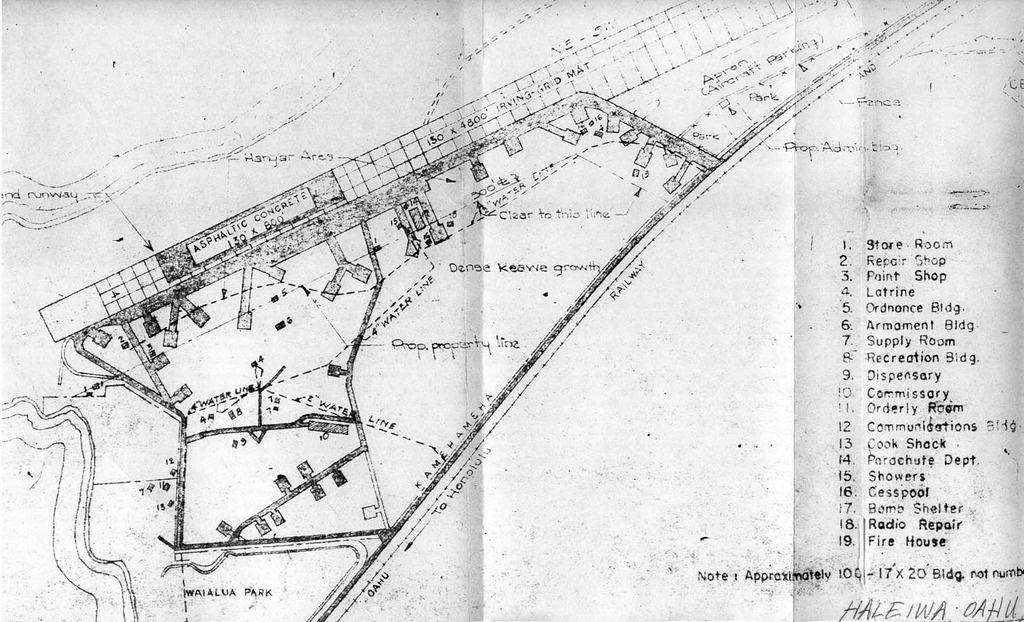
A 1946 plan depicted the Haleiwa airfield as having a single 4,400' “Irving-Grid Mat” runway,
within which was a 800' “Asphaltic Concrete” inset.
The Haleiwa Airport was apparently reused after WW2 (at least for a brief period of time) as a civilian airport.

The only photo which has been located showing Haleiwa reused as a civilian airport was a July 1946 aerial view looking north (courtesy of John Voss),
which showed 9 light single-engine taildraggers (Piper Cubs?).
Q.R. Wood recalled, “I was a Pvt/Pfc in the USMC & arrived in Hawaii aboard the aircraft carrier Shangri La.
I think it was April or May 1946.
I was stationed at MCAS Ewa for 2 years (almost to the day).
I spent most of my $75/90 a month to take flying lessons
from one of the flying services who had planes & buildings at the Haleiwa Airport.
As I remember it there were 7 Fixed Base Operations active during the time I was there.
I soloed there in a Piper J-3 Cub & went on to earn my Private Pilots license there too.”

"Haleiwa" was depicted as a civilian airport on the 1947 Hawaiian Islands Sectional Chart (courtesy of John Voss).
It was described as having a 4,800' hard-surface runway.
Alan Rausch recalled, “My dad was an enlisted navy pilot during WWII (rare).
After the war he stayed in Hawaii, he met my mother a native from Haleiwa.
He taught flying at the Haleiwa airstrip, they had a restaurant there too, 'The Crash Inn'.
One day a plane did just that.
My parents said they had the restaurant in 1947-48.
My dad taught for one of the flying schools from just after the war until about then.
My dad also said something about one of runways or part of one being metal not paved.”
The Haleiwa Airport was apparently abandoned at some point between 1948-61,
as it was not depicted at all on the 1953 USGS topo map,
or the 1961 Honolulu Sectional Chart (courtesy of John Voss).

A 2/15/65 aerial view of the remains of the Haleiwa airfield (from the University of HI).
Former HI resident Tom Kramer reported,
"The strip was made of concrete slabs when I saw it, as was the hardstand.
It did have some sort of control tower later on & the footers were there."

As seen in the 2000 NOAA aerial view,
the remains of the runway at Haleiwa are still recognizable.

A 2004 aerial view looking south at the former Haleiwa Fighter Strip runway.
In 2004 Marissa Guilford reported that the Hawaiian Historical Aviation Foundation
is proposing to preserve the Haleiwa Airfield & establish an air museum.

A 2005 photo by David Trojan of a building foundation which remains at the site of the Haleiwa Airfield
(courtesy of Colin Perry of the Hawaii Aviation Preservation Society).
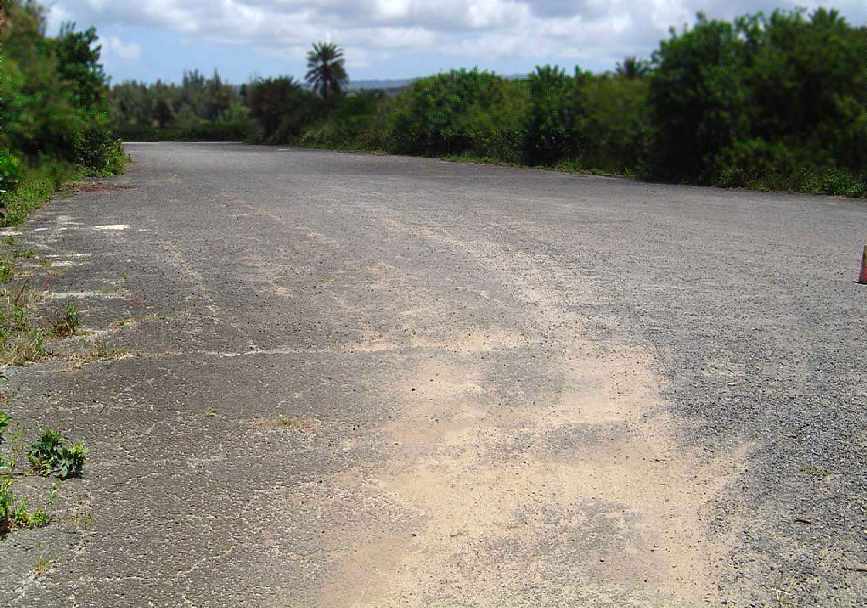
A 2005 photo by David Trojan of the remains of asphalt runway pavement at the site of the Haleiwa Airfield
(courtesy of Colin Perry of the Hawaii Aviation Preservation Society).
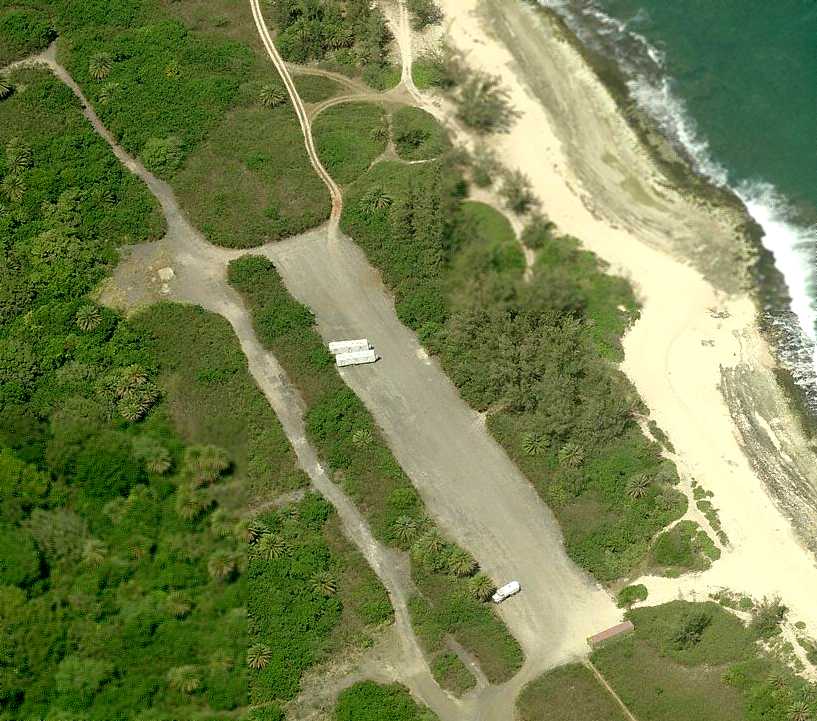
A circa 2007 aerial view looking west at the remains of asphalt runway pavement at the site of the Haleiwa Airfield.

An 8/23/14 photo by Timothy Williamson looking southwest along the remains of the Haleiwa runway.
The site of the Haleiwa Fighter Strip is located north of the intersection of Route 83 & Kahalewai Place.
See also: "Where Were You in '42: A Guide to World War II Historical Sites in Hawaii."
____________________________________________________
Mokuleia Army Airfield / Dillingham Air Force Base (HDH), Mokuleia, HI
21.58, -158.2 (Northwest of Honolulu, HI)

A circa 1941-42 aerial view looking southwest showing Mokuleia Field still under construction.
According to Hawaii resident Walter Dick, “Dillingham Field was built on part of an old ranch property.”
This field was originally built during WW2 as Mokuleia Field.
The date of construction of the Mokuleia Field has not been determined.
The earliest depiction which has been located of Mokuleia Field
was a circa 1941-42 aerial view looking southwest showing the field apparently still under construction,
with part of one runway paved, and the southern taxiway having been cleared.

The earliest photo which has been located showing Mokuleia Field in use was a February 1942 photo of P-40 Warhawks of the 72nd Pursuit Squadron
(courtesy of the 15th Airlift Wing History Office, via Colin Perry of the Hawaii Aviation Preservation Society).
This shot is fairly rare, in that it depicted a small bomb mounted under each P-40.

A 7/29/42 aerial view looking southwest at Mokuleia Field (courtesy of Dave Fahrenwald of Hawaiian Aviation History).
The field was already in its ultimate configuration,
with 2 paved parallel runways & a row of bunkers along the south side of the field.

A 1943 picture of a B-24 Liberator performing a run-up in the engine maintenance area
within a revetment at Mokuleia Field (courtesy of Tom Kramer).

The April 1945 V-450 Hawaiian Islands U.S. Navy Aviation Chart (courtesy of Chris Kennedy)
depicted Mokuleia as having a control tower.

Mokuleia was apparently closed at some point between 1945-47,
as it was labeled "Mokuleia (Closed)" on the 1947 Hawaiian Islands Sectional Chart (courtesy of John Voss).
It was described as having a 8,900' hard-surface runway.
At some point after 1947 the field was renamed Dillingham Air Force Base.
According to Hawaii resident Walter Dick, “Dillingham Field was renamed after Gaylord Dillingham,
(the youngest son of Walter Dillingham), who was lost during the war.
My mother worked for a Dillingham company her entire life.”
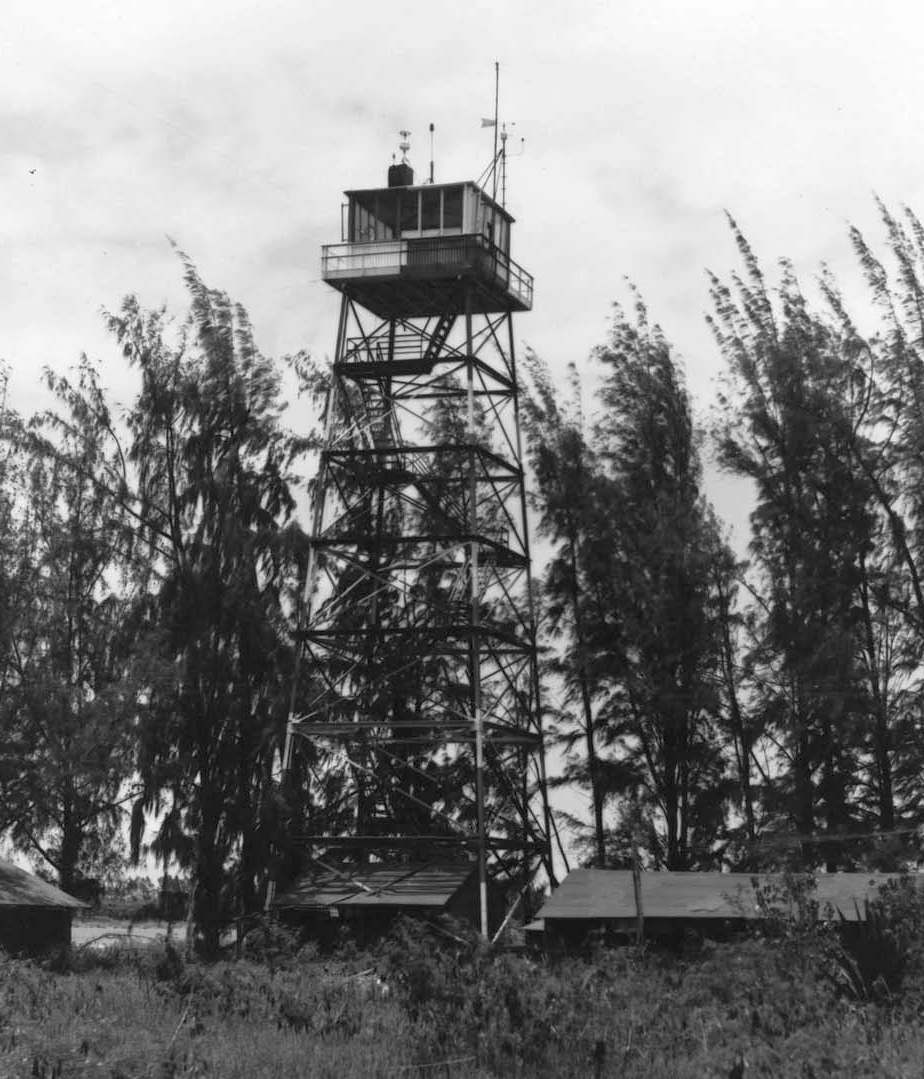
An 8/1/49 photo of Dillingham's control tower.

A 6/29/51 aerial view looking south at Dillingham (from the University of HI) showed no aircraft on the field or in its numerous parking revetments.

In this December 1953 aerial view of Dillingham
(courtesy of the 15th Airlift Wing History Office, via Colin Perry of the Hawaii Aviation Preservation Society),
two large multi-engine aircraft are visible on the runway, with several more in the revetments on the southwest side of the field,
and a large number of single-engine aircraft are visible along the revetments on the south side of the field.

The 1954 USGS topo map depicted Dillingham AFB as having 2 paved parallel runways,
along with a taxiway leading to the former revetments on the south side.
Dillingham was evidently closed at some point between 1953-54,
as it was labeled "Dillingham AFB (closed)" on the October 1954 Hawaiian Islands Sectional Chart (courtesy of Chris Kennedy).
The field was shown as having a paved 9,180' Runway 8/26.

"Dillingham AFB (closed)" was depicted on the 1955 Honolulu Local Aeronautical Chart (courtesy of Chris Kennedy)
as having a 9,200' hard surface runway.
According to Tom McGlynn, “Dillingham Field was used by a sports car club for a race event in 1957.
I believe it was the Associated Sports Car Clubs of Hawaii.
Lou Brero died that year of injuries received when a driveshaft U-joint broke & the driveshaft tore the gas tank causing the car to bust into flames.”
During the 1950s, a portion of the Dillingham Field site was used as the location
for the Army's Nike surface-to-air missile Battery OA-84 Launch Site.
Dillingham was still depicted as a closed airfield on the 1961 Honolulu Sectional Chart (courtesy of John Voss).
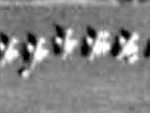
A closeup from an amazing 1962 aerial photo which showed no less than 32 A-4 Skyhawk attack jets on the northern ramp of Dillingham,
along with one slightly larger swept-wing tactical jet.
Was this some kind of Marine Corps field exercise, possibly related to that year's Cuban Missile Crisis?
Tim Haehnlen recalled, “In the 1960s... while attending a church sponsored camp next to Dillingham,
the Hawaii Air National Guard out of Honolulu International Airport practiced maneuvers & touch and gos with their F-102 Delta Daggers there almost daily.”
The Dillingham property was relinquished by the Air Force back to the Army in 1975.
At some point between 1975-77,
the Army allowed the airfield to be reopened as a civil airport through a joint-use agreement.
The remarks in the December 1977 Hawaiian Islands Sectional Chart (courtesy of Chris Kennedy) said,
"Open to civil use through agreement between the US Army & the State of Hawaii.
A 5,000' x 60' runway for light powered aircraft has been painted
in the center of the existing 9,000' x 100' paved area for civil use."
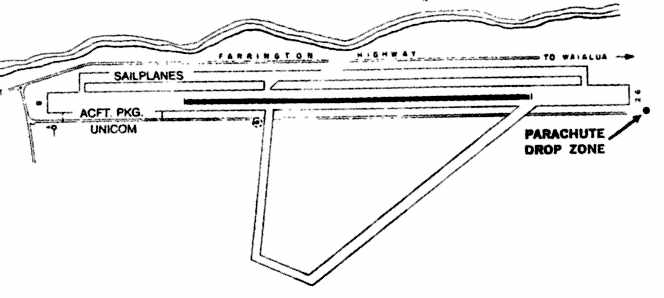
The 1981 Hawaii Airports & Flying Safety Guide (courtesy of Jonathan Westerling)
depicted Dillingham Airfield as having 2 parallel runways, with the shorter northern runway being designated for sailplanes,
along with the taxiway leading to the former revetments on the south side.
The airfield was described as being open to civil aircraft "for day VFR operations only."
The airport attendant was listed as Philip Chee.
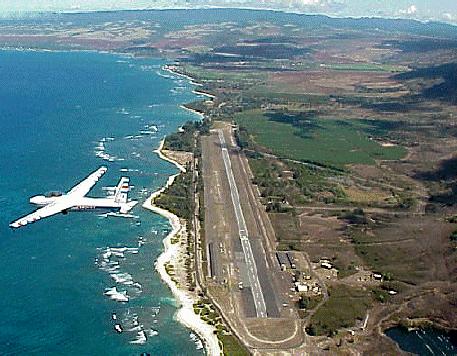
A circa 1980s-90s aerial view looking east at Dillingham.
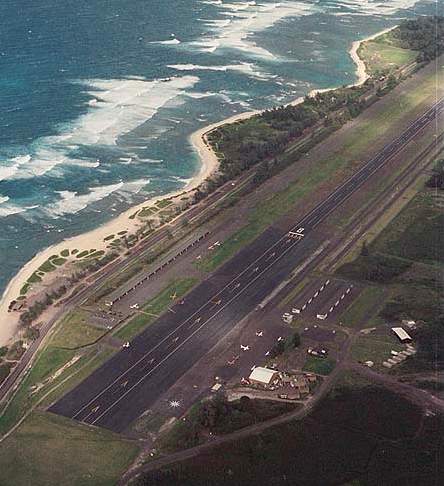
A 1990 aerial view looking northeast at Dillingham.
On July 8, 1997 soldiers with B Company, 214th Aviation Regiment
lifted & transported a Navy F/A-18 Hornet jet fighter from Dillingham to NAS Barbers Point,
with the help of MCB Hawaii's Landing Support Platoon, Landing Support Company, Combat Service Support Group 3.
The F/A-18 had been transported to Dillingham from MCAS Kaneohe Bay
more than 3 years previously to be turned into a static display for a never-opened military museum at NAS Barbers Point.
Using Landing Support Platoon's expertise in rigging Humvees & other such equipment for transport via helicopter,
the Army crew on the CH-47D Chinook helicopter carried the remodeled jet to its new home.
Dillingham is still used as a civilian airport, primarily to provide glider rides for tourists.
The Dilligham airfield consists of a paved 9,007' Runway 8/26.
A paved taxiway leads to numerous abandoned revetments on the south side.
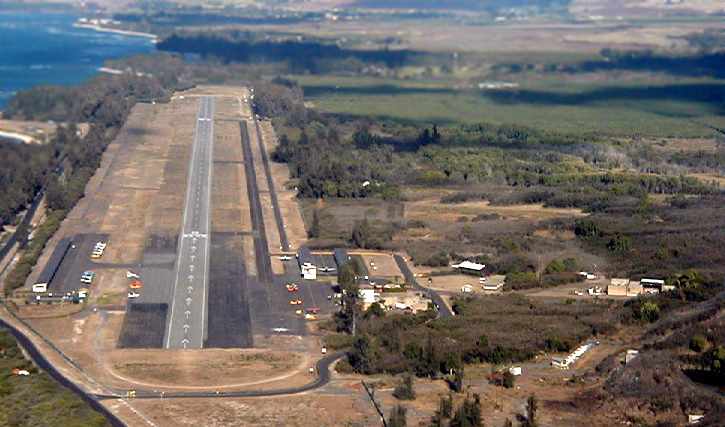
A circa 2000 aerial view looking east at Dillingham,
taken from final approach for Runway 8 (courtesy of Dave Fahrenwald of Hawaiian Aviation History).

A circa 2000 photo of the ruins of a brick building
near Dillingham's former Nike missile site (courtesy of Dave Fahrenwald of Hawaiian Aviation History),

A circa 2000 photo looking southwest along Dillingham's abandoned taxiway (courtesy of Dave Fahrenwald of Hawaiian Aviation History).

A circa 2000 photo of one of the concrete revetments near the airfield (courtesy of Dave Fahrenwald of Hawaiian Aviation History).
See the 1943 picture at the top of this section of a B-24 parked inside one of the same revetments.
R. Arnold reported in 2003 that "Dillingham has been a general aviation field for several years now.
It has an active glider base, sky diving club, and many private aircraft are based there.
I fly in & out of Dillingham on a weekly basis."

A 2007 photo of a large portion of a Lockheed L-1011 fuselage, used to film scenes for the TV show “Lost”,
which is stored on a ramp adjacent to the south side of the middle of Dillingham's runway.
This is only minutes away from the wreckage filming location at Mokuleia Beach.
A Beech 18, used to depict a drug smuggler's plane on the show, is visible on the left.

An 8/23/14 photo by Timothy Williamson looking north at the Dillingham control tower.

A 2015 aerial view looking northeast at Dillingham Field, with the numerous remains of revetments visible at bottom-right.
____________________________________________________
Since this site was first put on the web in 1999, its popularity has grown tremendously.
That has caused it to often exceed bandwidth limitations
set by the company which I pay to host it on the web.
If the total quantity of material on this site is to continue to grow,
it will require ever-increasing funding to pay its expenses.
Therefore, I request financial contributions from site visitors,
to help defray the increasing costs of the site
and ensure that it continues to be available & to grow.
What would you pay for a good aviation magazine, or a good aviation book?
Please consider a donation of an equivalent amount, at the least.
This site is not supported by commercial advertising –
it is purely supported by donations.
If you enjoy the site, and would like to make a financial contribution,
you
may use a credit card via
![]() ,
using one of 2 methods:
,
using one of 2 methods:
To make a one-time donation of an amount of your choice:
Or you can sign up for a $10 monthly subscription to help support the site on an ongoing basis:
Or if you prefer to contact me directly concerning a contribution (for a mailing address to send a check),
please contact me at: paulandterryfreeman@gmail.com
If you enjoy this web site, please support it with a financial contribution.
please contact me at: paulandterryfreeman@gmail.com
If you enjoy this web site, please support it with a financial contribution.
____________________________________________________
This site covers airfields in all 50 states.